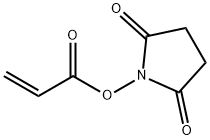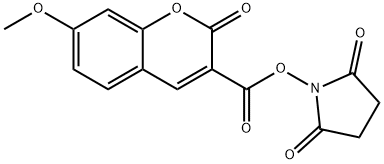N-ACRYLOXYSUCCINIMIDE
Synonym(s):N-Acryloxysuccinimide
- CAS NO.:38862-24-7
- Empirical Formula: C7H7NO4
- Molecular Weight: 169.13
- MDL number: MFCD00078261
- SAFETY DATA SHEET (SDS)
- Update Date: 2023-06-08 17:06:36

What is N-ACRYLOXYSUCCINIMIDE?
Chemical properties
yellow crystals and chunks
The Uses of N-ACRYLOXYSUCCINIMIDE
sulfhydryl reactive cross-linking reagent affording sulfides and HI, can subsequently be radio-iodinated, the phenylazide function can then be photo-activated with long wavelength UV light to couple with another molecule
The Uses of N-ACRYLOXYSUCCINIMIDE
Acrylic acid N-hydroxysuccinimide ester (NAS) is a general acrylating agent that is used in the synthesis of:
- Acrylated hyaluronic acid (HA) hydrogel for bone regeneration applications.
- Injectable, biodegradable, and thermosensitive copolymers for tissue engineering.
- Imidazole-based biocompatible, aqueous quantum dots (QDs).
What are the applications of Application
Acrylic acid N-hydroxysuccinimide ester is a homopolymer linker used to fabricate multifunctional copolymers
Properties of N-ACRYLOXYSUCCINIMIDE
| Melting point: | 69 °C |
| Boiling point: | 298.4°C (rough estimate) |
| Density | 1.4523 (rough estimate) |
| refractive index | 1.5500 (estimate) |
| storage temp. | 2-8°C |
| solubility | soluble in Toluene |
| form | Crystals and Chunks |
| color | Yellow |
| CAS DataBase Reference | 38862-24-7(CAS DataBase Reference) |
Safety information for N-ACRYLOXYSUCCINIMIDE
| Signal word | Warning |
| Pictogram(s) |
 Exclamation Mark Irritant GHS07 |
| GHS Hazard Statements |
H302:Acute toxicity,oral H319:Serious eye damage/eye irritation |
| Precautionary Statement Codes |
P264:Wash hands thoroughly after handling. P264:Wash skin thouroughly after handling. P270:Do not eat, drink or smoke when using this product. P280:Wear protective gloves/protective clothing/eye protection/face protection. P301+P312:IF SWALLOWED: call a POISON CENTER or doctor/physician IF you feel unwell. P305+P351+P338:IF IN EYES: Rinse cautiously with water for several minutes. Remove contact lenses, if present and easy to do. Continuerinsing. P337+P313:IF eye irritation persists: Get medical advice/attention. |
Computed Descriptors for N-ACRYLOXYSUCCINIMIDE
New Products
Tert-butyl bis(2-chloroethyl)carbamate 4-Methylphenylacetic acid N-Boc-D-alaninol N-BOC-D/L-ALANINOL N-octanoyl benzotriazole 3-Morpholino-1-(4-nitrophenyl)-5,6-dihydropyridin- 2(1H)-one Furan-2,5-Dicarboxylic Acid DIETHYL AMINOMALONATE HYDROCHLORIDE 1,1’-CARBONYLDIIMIDAZOLE R-2-BENZYLOXY PROPIONIC ACID 1,1’-CARBONYLDI (1,2-4 TRIAZOLE) N-METHYL INDAZOLE-3-CARBOXYLIC ACID (2-Hydroxyphenyl)acetonitrile 4-Bromopyrazole 5-BROMO-2CYANO PYRIDINE 5,6-Dimethoxyindanone 5-broMo-2-chloro-N-cyclopentylpyriMidin-4-aMine 2-(Cyanocyclohexyl)acetic acid 4-methoxy-3,5-dinitropyridine 1-(4-(aminomethyl)benzyl)urea hydrochloride 2-aminopropyl benzoate hydrochloride diethyl 2-(2-((tertbutoxycarbonyl)amino) ethyl)malonate tert-butyl 4- (ureidomethyl)benzylcarbamate Ethyl-2-chloro((4-methoxyphenyl)hydrazono)acetateRelated products of tetrahydrofuran



![(E)-5-[2-(2-CARBOXYVINYL)]-2'-DEOXYURIDINE N-HYDROXY-SUCCIMIDE ESTER](https://img.chemicalbook.in/CAS/GIF/869355-24-8.gif)




You may like
-
 Acrylic acid N-hydroxysuccinimide ester 98% (GC) CAS 38862-24-7View Details
Acrylic acid N-hydroxysuccinimide ester 98% (GC) CAS 38862-24-7View Details
38862-24-7 -
 N-Acryloxysuccinimide 96% CAS 38862-24-7View Details
N-Acryloxysuccinimide 96% CAS 38862-24-7View Details
38862-24-7 -
 N-Succinimidyl Acrylate CAS 38862-24-7View Details
N-Succinimidyl Acrylate CAS 38862-24-7View Details
38862-24-7 -
 Acrylic acid N-hydroxysuccinimide ester CAS 38862-24-7View Details
Acrylic acid N-hydroxysuccinimide ester CAS 38862-24-7View Details
38862-24-7 -
 1975-50-4 98%View Details
1975-50-4 98%View Details
1975-50-4 -
 14714-50-2 (2-Hydroxyphenyl)acetonitrile 98+View Details
14714-50-2 (2-Hydroxyphenyl)acetonitrile 98+View Details
14714-50-2 -
 118753-70-1 98+View Details
118753-70-1 98+View Details
118753-70-1 -
 733039-20-8 5-broMo-2-chloro-N-cyclopentylpyriMidin-4-aMine 98+View Details
733039-20-8 5-broMo-2-chloro-N-cyclopentylpyriMidin-4-aMine 98+View Details
733039-20-8
Statement: All products displayed on this website are only used for non medical purposes such as industrial applications or scientific research, and cannot be used for clinical diagnosis or treatment of humans or animals. They are not medicinal or edible.